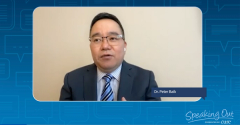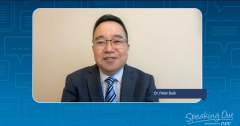
Evaluating Existing and Future Surgical Options for Early-Stage Lung Cancer
As part of its “Speaking Out” video series, Dr. Peter Baik, on behalf of Cancer Treatment Centers of America, discussed how far the space has come with surgical advances, and where it is headed, in treating early-stage lung cancer.
Transcription:
This video series featured, Dr. Peter Baik, who is a thoracic surgeon at Cancer Treatment Centers of America® (CTCA) in Phoenix and Chicago, and was moderated by Kristie L. Kahl.
Kahl: To start, can you describe what early-stage disease is and what would qualify a patient in this setting for surgery if that was an option for them?
Baik: So early stage, we can consider that as for localized disease, it's within the lungs. It may involve just the lymph nodes within the lung itself, but that has not traveled anywhere else. And of course, if the lesion is too big, then it may not be prudent to do the surgery first. But it all depends on the size, the lymph node status and where the tumor is high.
Kahl: What are our current options for surgery in lung cancer?
Baik: So it's actually very exciting these days, because there's a new study that came out that showed that you don't have to take the entire lobe, if it's a tumor that's less than 2 centimeters, and it's peripheral in nature. The reason why that's important is because there are a lot of patients, especially in lung cancer, because a lot of times they are smokers, they have a limited lung function or reserved (lung function). And so you want to preserve the lung function as much as possible. So you have traditional lobectomy, which is taking the entire lobe, or the section that contains a lung, the tumor, or a segmentectomy. It's an anatomic resection, not just a wedge, but following the pulmonary artery or vein, the airway, and you're actually getting that whole area, but not the entire lobe.
Kahl: Ere there any particular effects or long-term side effects that patients should be aware of with any of these surgical options?
Baik: Surgery has its own risks. It doesn't matter if you're doing a pinky surgery or if you're doing a major heart surgery, the risks are always there. However, because it's long surgery, and it's connected with the heart, then there's differentials. So it does have increased risks than say, you know, cosmetic surgery. However, with the advancement of robotics and minimally-invasive techniques, the complications have gone down dramatically. However, there are always risks associated with it, including heart attack, you could get irregular heart rhythms. The things that we see, especially in long-term smokers are air leaks, and that may cause the chest tube to stay in longer than we want. With the lobectomy or any lung resection, you could have certain shortness of breath afterwards. And that may be if you're a marathon runner, you may not be able to run the marathon afterwards. Or if you go shopping, you may get more short breath. And occasionally patients do need oxygen. But we test all those things before surgery to tell them, “You may need oxygen afterwards. Is that okay with you?” And so it's shared decision making that we have to do.
Kahl: Is there anything either before to help prep for surgery or even after to negate these effects?
Baik: the most important thing is quitting smoking. That's number one. Of course, nicotine is very addictive. We understand that. However, for the long term health and the best overall survival, quitting smoking will be the best thing. Number two is you have to keep moving. You have to exercise. Patients who are active before surgery will be able to recover faster, patients who are walking every day, they will be able to do that afterwards. If you just stay home and not walk and just watch TV all day, your body is not used to having the type of stress that you go under with any surgery.
Kahl: We hear a lot about how treatments have come a long way but with surgery. How far have we come with surgery and lung cancer and what do we have to look forward to?
Baik: We definitely went from open procedures, making a big cut, cutting through all these muscle layers. Traditional open procedures versus minimally invasive procedures we're doing has to be equal. Because in cancer surgery, the most important thing is to make sure we get all the cancer out, we do lymph node dissection. But because of the minimally invasive (procedure), you're able to go back to work earlier, have less pain. And when you have less pain, you can breathe better.
And so it's amazing. Right now, there are so many new robotic platforms coming out, new tools coming out. And maybe even for really small lesions, instead of surgery, can we locally get rid of (the disease)? And all those things are being looked into. But it's not there yet, but it's coming. And as we get more data on those patients, and how long patients will survive, the most important thing is to get rid of the cancer, and have the longest life expectancy as possible. And so all those things are coming up. And it's actually quite exciting.
Transcription edited for clarity and conciseness.
For more news on cancer updates, research and education, don’t forget to







